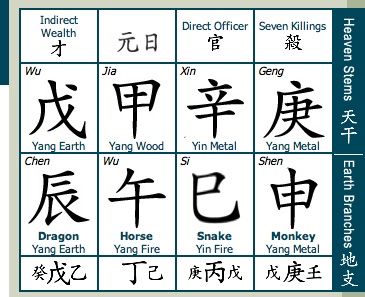Whilst browsing via Zite, I came across an article on Bloomberg Businessweek entitled “Are Creative People More Dishonest?“
Interestingly, the article was accompanied by a photograph of Bernard Madoff. Yes he of Ponzi scheme fame. The article references the work of Dan Ariely, whose book, ‘Predictably Irrational’ is one of my favourite reads. (lest anyone here hasn’t realised it by now, BaZi is entirely about Behavior and has a lot of co-relation to Behavioral Economics)

I have excerpted several interesting parts of the article:
Studies conducted by Francesca Gino of Harvard Business School and Dan Ariely of Duke University suggest that creativity fuels dishonesty and that dishonest behavior triggers creativity. “It may be a cycle that reinforces itself,” says Gino. “You could have a situation in which creativity initially pushes you across the line and then dishonesty heightens creativity, which might make it easier to cheat again. It’s a downward spiral.
Creative types are simply “at a higher risk for behaving unethically because they can more easily find reasons why their behavior is not problematic,” says Gino. In other words, original thinkers aren’t more ethically depraved than the rest of us; they’re just better equipped to find ways of being dishonest without compromising their own self-regard.”
From a BaZi standpoint, it is easy to understand this idea if you have an understanding of what are the Stars that are involved in the ‘creativity’ and ‘original thinking’ category, along with the ‘cheating’ and ‘dishonest’ behaviour category. Of course, the Behavioral Economists in the article are trying to work out IF Creative types are more likely to be dishonest and in BaZi, the composition of certain stars, predisposes a person to a greater likelihood to be creatively dishonest.
So, how do we find the creatively dishonest person or the cheating creative?
One of the best ways to frequently understand how a type of behaviour can manifest is to simply look at examples. Two examples stand out in my mind as the example of creatively dishonest: Bernard Madoff and Steve Jobs. [If you are wondering why Mr Jobs is on the creative dishonest list, its simply that it is well known that he often skated the line of innovation…the classic example being the Mouse, which many claim was ‘borrowed’ from a visit to the Xerox PARC lab]

Bernard Madoff's BaZi Chart (Time Not Accurate)
Steve Jobs chart is as follows:

A number of stars can result in dishonesty or dishonest behaviour:
- Indirect Wealth can be dishonest because it is it is inclined towards shortcut success and because it has a ‘doesn’t matter how, as long as it gets done’ mindset. This attitude creates a predisposition towards dishonesty or cheating because it provides instant outcomes.
- Rob Wealth can be dishonest because it is inclined towards achieving things quickly, and likes to use Huckleberry Finn tactics (it’s not stealing if you are making it better)
- Indirect Resource is highly likely to be sly or at the very least disingenuous because again, it is the Star of shortcuts but also the star of ingenuity and thinking out of the box. And thinking out of the box by necessity involves thinking of ways to do it which involve skirting the rules or unorthodox methods. In particular, the Gino-Ariely study makes note that “original thinkers aren’t more ethically depraved than the rest of us; they’re just better equipped to find ways of being dishonest without compromising their own self-regard” – recall the Indirect Resource strengthens the Day Master whilst giving the person the ability to think out of the box or original-think. Further, in some instances, the Indirect Resource Star may also contain within it the Friend Star/Rob Wealth, which thus further enables people to engage in dishonesty without affecting Self-Regard. In other words, these are the people who are quite capable of lying to themselves.
- Eating God may be inclined towards cheating or dishonesty but is more orientated on gaming the system because ‘the system is stupid so I’ll take advantage of it because I’m smart’ – this is an intellectual cheat if you like.
- Hurting Officer is potentially inclined to cheat because they are about breaking the rules. However, people who cheat USUALLY do not like to tell the whole world that they have cheated, which does not necessarily sit well with the showboat ways of the Hurting Officer. The Hurting Officer is therefore in my view more inclined to break rules openly or be very candid with their dishonesty.
- 7 Killings is extremely inclined to play dirty, cheat and be dishonest because 7 Killings is all about winning, no matter what.
Now, it is not enough to have a dishonest behaviour star or stars in your chart alone to create a circumstance where a person will engage in creative dishonesty. You also need an additional pre-condition which is that the Honesty Stars are either weak or ineffectual or not needed in the chart. As such, the Direct Resource and Direct Officer Stars, or the Direct Wealth Star, must be weak or not present in the chart or not needed in the chart (especially the Officer Star) in order for the person to actually engage in creative dishonesty.
So, if we look at the chart of Bernard Madoff (sans Time of Birth), we will notice that the Month Branch (which always is a tipping point when it comes to determining inherent personality and behaviour) contains the Indirect Wealth and Eating God Stars. Although Bing Fire is prominent in the chart, this Star combines with the Day Master to produce Water, which creates an Indirect Hurting Officer Star (a Hurting Officer Star which is showy but has Eating God tendencies). The Day Pillar itself contains the Indirect Wealth Star, indicating a strong tendency towards again, shortcut methods of attaining wealth. Now, strictly speaking, Madoff did not engage in any form of exceptionally creative dishonesty – the Ponzi scheme per Wiki is named after Charles Ponzi, who first perpetuated it in 1920 but the origins of the Ponzi scheme go back to the time of Dickens. He was simply BOLD enough to actually do it. So in this respect, Madoff cannot really be said to be a creative dishonest person – he was just outright dishonest. Notably in this chart, the Rob Wealth Star is required, indeed, is needed to help the extremely weak Day Master – although the Rob Wealth Star, if needed, would tend to manifest its positive attributes, it should be recalled that in itself, the Rob Wealth Star has slightly dishonest (or at least, shortcut driven) tendencies.
In the case of Steve Jobs chart, the combination of Indirect Resource and Eating God (combining to produce the Self Star, which is Fire) clearly indicates a tendency to buy into the Piccassoian notion that it’s not stealing it you make it bigger than the sum of what it is – good artists copy, great artists steal. Throughout Jobs recently released ‘official’ biography, many people mention Jobs tendency to pass off ideas as his own. That is a form of creative dishonesty.
httpv://www.youtube.com/watch?v=CW0DUg63lqU
The Eating God-Indirect Resource tendency produces an individual who believes that he is superior to others intellectually – as such, in their minds, any form of creative dishonesty isn’t about cheating or dishonesty – it’s simply about the superiority of the idea or the outcome. If they gamed the system and it worked, then its not because they cheated, but because the system was stupid or inferior and deserved to be replaced. (incidentally, one of Jobs very first entrepreneurial endeavours involved building a device called a Blue Box that enabled people to make long-distance phone calls for free or very little money). In the instance of Eating-God + Indirect Resource personalities, money is rarely the motivation for the creative dishonesty – instead, it is about a triumph of the intellect or the superiority of the idea.
Indirect Resource + Indirect Wealth however will obviously yield a different outcome – this is the model more commonly seen in the financial industry. The charts of rogue traders Jerome Kerviel (Soc-Gen, 2008) and Kweku Adoboli (UBS, 2011) strongly suggest that Indirect Resource paired with Wealth Stars or 7 Killings yields high risk creative dishonesty. In both instances of the charts, the Indirect Resource Star is a key Star as it is needed.

Jerome Kerviel (time not accurate)

A final point however is that environmental factors matter as well in the outcome. One thing that Gino-Ariely’s paper doesn’t look at is how creativity in other industries (like the financial industry) results in dishonesty. Instead, the suggestion from Ariely’s book is that financial dishonesty is because of greed. In BaZi however, it’s fundamentally driven by one key star in my view, and that’s the Indirect Resource Star and what is it coupled with (both within the Branch, and inside the chart)
The composition of these Stars in the absence of opportunity in which to engage in cheating/dishonest behaviour in the first place, will reduce the likelyhood of such behaviour. So for example, in the financial industry, where the focal point is on performance (irregardless of how it is achieved) and making money (no matter how you do it), the rise of the Indirect Wealth/Indirect Resource/7Killings/Rob Wealth types (look at all the charts of the major partipants of the Wall Street 2008 financial disaster), in contrast to the traditional Direct Wealth, Direct Officer, Direct Resource profile of old school bankers, has corresponded with the demands of the industry. In the tech industry, Indirect Resource coupled with Output Stars tends to result in innovation dishonesty (idea stealing) as opposed to financial dishonesty (stealing money). In this regard, it can be argued that we think its okay for someone to break the rules if the end result is something really cool, but it’s not okay to break the rules if it results in a corporation losing billions.








greetings, interesting piece, but what makes a creatively honest personality. my chart is geng-xi-xu-geng/zi-si-zi-wu…xin metal DM. my direct officer is weak and my direct wealth is missing. also, my direct resource is strong. would this fit into the creatively dishonesty pile?
First off, your description of your chart is completely confusing – can’t understand what is the composition at all – fortunately you included the DM. I have no idea if that is the sequence from Year to Hour or Hour to Year and for that matter, the spellings are difficult to follow. Secondly, you don’t have strong IR – so at least on your assessment of the chart, one would conclude you are not in the pile. Unless of course, you think you should be in the pile.
pardon the confusion. the chart reads from left to right, hour to year…
HOUR DAY MONTH YEAR
GENG XIN XU GENG
ZI SI ZI WU
FYI there is no such stem as Xu – I think you meant Wu. Anyway, as i mentioned, you would not be considered creative dishonest.
Thanks i always get the two mixed up
Hi,
Could you help me to interpret my chart?
YYMMDDHH
Yi Chou – Wu Yin – Jia Shen – Yi Hai
Am I a strong DM? What is the useful god? What kind of business suit my bazi chart?
Tq
Khun
hi sorry I do not provide free consultations via my blog.
But on technical questions, I will usually answer.
So, this would be consider weak Wu Earth DM.
hi,
natal chart
hour day month year
ren xin xin ding
chen wei hai mao
am i a strong daymaster?
Weak.